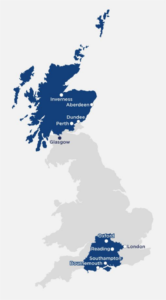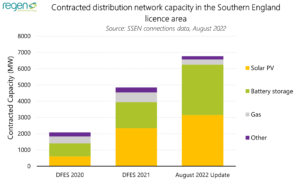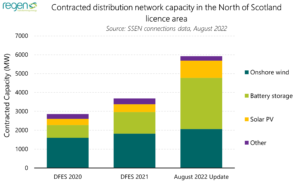Against a backdrop of the energy crisis and economic turbulence. Regen highlights the low carbon technology pipeline.
 The energy crisis and economic turbulence have created a challenging environment for investment in many parts of the economy. However, Regen’s latest analysis suggests that investment in low carbon energy projects is, if anything, speeding up – with a strong pipeline of projects coming forward for development.
The energy crisis and economic turbulence have created a challenging environment for investment in many parts of the economy. However, Regen’s latest analysis suggests that investment in low carbon energy projects is, if anything, speeding up – with a strong pipeline of projects coming forward for development.
Over recent months Regen has been carrying out analysis for SSEN, ahead of their annual Distribution Future Energy Scenarios study, of the technologies connecting to the distribution network in the North of Scotland and Southern England licence areas.
See the summary reports for the North of Scotland licence area and Southern England licence area.
The number of battery electric vehicles in Southern England licence area has more than doubled, from 50,000 to over 100,000, in a little over six months to end Q1 2022. In the North of Scotland there has been an 82% increase in registrations in the same period. The number of Heat Pumps connected in the Southern England licence area has grown 155% from 1,800 to 4,600 in the past year with a similar increase in the North of Scotland.
Figure 1 (right): The North of Scotland and Southern England licence areas. Source: SSEN

Figure 2: Contracted distribution connected capacity in the Southern England licence area, 2022 to Aug 2022
Source – SSEN connections data
In the Southern England licence area, solar PV and battery storage sites account for most of the contracted network capacity. The pipeline of battery projects has nearly doubled over the past year.

Figure 3: Contracted distribution connected capacity in the North of Scotland licence area, 2020 to Aug 2022
Source – SSEN connections data
In the North of Scotland licence area, onshore wind and battery storage projects make up the majority of the projects in the pipeline. Strong investor interest in storage and solar has seen in a marked growth in new projects over the past year.
While these large and growing pipelines of wind, solar and battery storage projects are a positive sign of investor interest, they also demonstrate the challenge of getting a connection to an increasingly constrained network, with lack of capacity on the transmission network now the biggest challenge.
Getting these projects connected and energised; making sure networks are able to support the electrification of transport and heat, as well as new housing and economic growth, will be critical, not just for the economy and levelling up agenda, but also for the fairness and equity of the energy transition. Ofgem’s forthcoming RIIO ED2 determinations of investment in our distribution networks to prepare for load growth are a key moment in our path to net zero.
When Liz Truss was Secretary of State for DEFRA, she reminded us that “environmental and economic progress…are not just compatible – they depend on each other”[1]. Regen’s analysis shows again just how much potential there is for sustainable growth in the low carbon energy sector, provided we have the right policy framework and investment in our energy networks.
[1] https://www.gov.uk/government/speeches/elizabeth-truss-speech-on-the-environment-and-the-rural-economy
Blog by Energy Analyst Bruce Bardsley.
